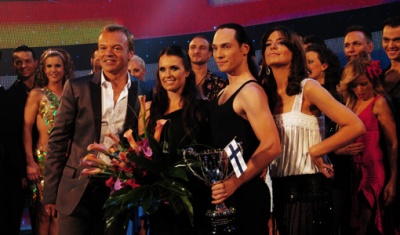Eurovision Dance Contest
(→Co-hosts) |
|||
| Line 8: | Line 8: | ||
== Co-hosts == | == Co-hosts == | ||
| - | Commentators: Len Goodman (2007, 2008) with [[Bruno Tonioli]] (2007), [[Craig Revel Horwood]] (2008) | + | Commentators: [[Len Goodman]] (2007, 2008) with [[Bruno Tonioli]] (2007), [[Craig Revel Horwood]] (2008) |
== Broadcast == | == Broadcast == | ||
Revision as of 14:04, 8 September 2008
Contents |
Host
When staged in UK:
Graham Norton and Claudia Winkleman (2007, 2008)
Co-hosts
Commentators: Len Goodman (2007, 2008) with Bruno Tonioli (2007), Craig Revel Horwood (2008)
Broadcast
Splash Media / Sunset + Vine for BBC1, 1 September 2007 -
Synopsis
It's what happened when Strictly Come Dancing went for a night on the town, hooked up with the Eurovision Song Contest, and both staggered home after a few too many jars.
Eurovision Dance Contest is a competition between dancers representing their countries. The format of the contest is simple: each of the competing countries sends a pair of dancers (one man, one woman). Each couple will dance twice, the first is a formal dance (ballroom or Latin) and the second a free-form dance that somehow reflects the national character of the competing country. This can be as clear as using a traditional Irish or Greek dance, or as weak as flashing the country's flag during the performance.
The contest built from the success of the Strictly Come Dancing format, and the BBC staged the first two events. The 2007 competition took place in a studio at Television Centre, and allowed countries to nominate whoever they wished - the Finnish winners were two professional dancers. As had become traditional at Eurovision events, the viewers were able to determine the winner through televoting and (outside the UK) SMS voting. The scoring system was the traditional 12-10-8-to-1.
2008's event was held at the Scottish Exhibition and Conference Centre near Glasgow, and introduced a rule that only one of the competing couple should be a professional dancer, the other must be known for something else. It's aimed at bringing in national celebrities, tightening the format's links to Strictly.... That year's contest also introduced an international jury, made up of International Dance Sport Federation experts from non-competing countries. Their votes were weighted to the equivalent of four countries.
Additionally, the two dances were merged after the competitors all did one of about four ballroom/Latin dances last year to a single freestyle dance which contained ballroom/Latin elements and some form of national flavour, although both aspects seem very loosely defined. This created a wider variety of dance styles, and a surprising array of 'fusion' dances. It also introduced what may become the contest's equivalent of the Song Contest's arbitrary key change - The arbitrary dance style change (...And, in some cases, backing music change)
Unlike the predecessor Eurovision Young Dancers contest, and the Junior Eurovision Song Contest, the BBC found this was a perfect format for Saturday primetime, and the two shows aired on BBC1.


